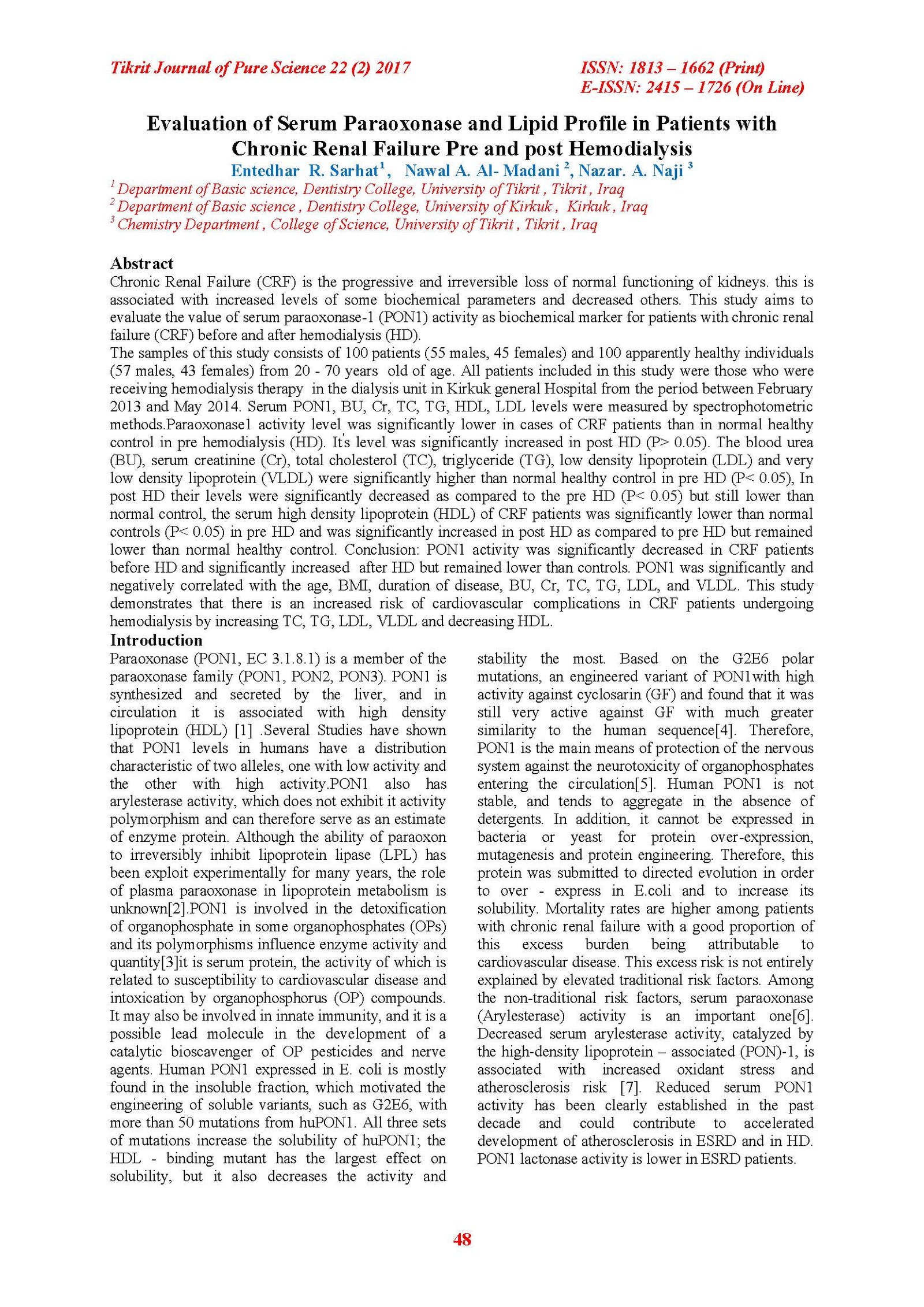Evaluation of Serum Paraoxonase and Lipid Profile in Patients with Chronic Renal Failure Pre and post Hemodialysis
Main Article Content
Abstract
Chronic Renal Failure (CRF) is the progressive and irreversible loss of normal functioning of kidneys. this is associated with increased levels of some biochemical parameters and decreased others. This study aims to evaluate the value of serum paraoxonase-1 (PON1) activity as biochemical marker for patients with chronic renal failure (CRF) before and after hemodialysis (HD).
The samples of this study consists of 100 patients (55 males, 45 females) and 100 apparently healthy individuals (57 males, 43 females) from 20 - 70 years old of age. All patients included in this study were those who were receiving hemodialysis therapy in the dialysis unit in Kirkuk general Hospital from the period between February 2013 and May 2014. Serum PON1, BU, Cr, TC, TG, HDL, LDL levels were measured by spectrophotometric methods.Paraoxonase1 activity level was significantly lower in cases of CRF patients than in normal healthy control in pre hemodialysis (HD). It's level was significantly increased in post HD (P> 0.05). The blood urea (BU), serum creatinine (Cr), total cholesterol (TC), triglyceride (TG), low density lipoprotein (LDL) and very low density lipoprotein (VLDL) were significantly higher than normal healthy control in pre HD (P˂ 0.05), In post HD their levels were significantly decreased as compared to the pre HD (P˂ 0.05) but still lower than normal control, the serum high density lipoprotein (HDL) of CRF patients was significantly lower than normal controls (P˂ 0.05) in pre HD and was significantly increased in post HD as compared to pre HD but remained lower than normal healthy control. Conclusion: PON1 activity was significantly decreased in CRF patients before HD and significantly increased after HD but remained lower than controls. PON1 was significantly and negatively correlated with the age, BMI, duration of disease, BU, Cr, TC, TG, LDL, and VLDL. This study demonstrates that there is an increased risk of cardiovascular complications in CRF patients undergoing hemodialysis by increasing TC, TG, LDL, VLDL and decreasing HDL.
Article Details

This work is licensed under a Creative Commons Attribution 4.0 International License.
Tikrit Journal of Pure Science is licensed under the Creative Commons Attribution 4.0 International License, which allows users to copy, create extracts, abstracts, and new works from the article, alter and revise the article, and make commercial use of the article (including reuse and/or resale of the article by commercial entities), provided the user gives appropriate credit (with a link to the formal publication through the relevant DOI), provides a link to the license, indicates if changes were made, and the licensor is not represented as endorsing the use made of the work. The authors hold the copyright for their published work on the Tikrit J. Pure Sci. website, while Tikrit J. Pure Sci. is responsible for appreciate citation of their work, which is released under CC-BY-4.0, enabling the unrestricted use, distribution, and reproduction of an article in any medium, provided that the original work is properly cited.
References
[1] Alejandro Gugliucci. 2012.Regulation of Hepatic Paraoxonase-1 Expression. Journal of LipidS. 684010. 5. 2012.
[2] David N. Nevin, et al. 2014. Arteriosclerosis, Thrombosis, and Vascular Biology: Paraoxonase Genotypes, Lipoprotein Lipase Activity, and HDL. American Heart Association..
[3] Fortenberry GZ, et al. 2014 Paraoxonase1 polymorphisms and attention / hyperactivity in school - age children from Mexico City, Mexico. PubMed U.S. National Institutes of Health. Epub. 132: 342-9.
[4] Mohosin Sarkar, et al. 2012. Solubilization and Humanization of Paraoxonase-1. Journal of Lipids.
[5] Mikail Arslan, Mahmut Erzengin and Dudu Demir. Comparison of Serum Paraoxonase1 (PON1) Activities Among Different Sheep Breeds in Turkey.
Medwell Journals: Journal of Animal and Veterinary Advances. 10(4);489-494. [6] Balasubramaniam Gayathri, et al.2011. Serum Paraoxonase (Arylesterase) Activity in Chronic Renal Failure. Journal of Medicine, Bangladesh Journals OnLine (Bangla JOL). 12; 1.
[7] David J. Kennedy, et al.2013. Diminished Antioxidant Activity of High‐Density Lipoprotein–Associated Proteins in Chronic Kidney Disease. Journal of the American Heart Association J Am Heart Assoc. 2, 104.
[8] Mackness, M.I., D. Harty, D. Bhatnagar, P.H. Winocour, S. Arrol, M. Ishola, and P.N. Durrington. 1991. Serum paraoxonase activity in familial hypercholesterolemia and insulin-dependent diabetes mellitus. Atherosclerosis.; 86:193–199.
[9] Gadicheria S, et al. 2013. Study of Serum Paraoxonase Activity in Chronic renal failure. Scope Med..
[10] Shilpa KS. 2014. Effect of Hemodialysis in Patients with Chronic Renal Failure on Lipid Profile, Serum Paraoxonase-1 Activity and Malondialdehyde Levels. Rajiv Gandhi University of Health.
[11] Nagane N S., and Ganu JV. 2011. Lipid Profile and Serum Paraoxonase1 Activity in CRF Patients Pre and Post Hemodialysis.
[12] Alejandro Gugliucci et al.2012. Paraoxonase1 in chronic kidney failure. Journal. 2012, ( 2012); 10.
